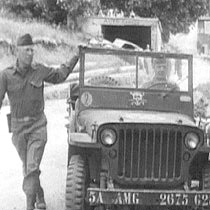-
(单词翻译:双击或拖选)
By Jeff Swicord
Washington
18 June 2007
They were the men assigned to save Europe's great art treasures during World War Two. In early 1943, the U.S. and its allies learned that the Nazis2 were confiscating3 great works of art across Europe. In response, President Franklin D. Roosevelt established the American Commission for the Protection and Salvage4 of Artistic5 and Historic Monuments in War Areas. The men assigned to the job became known as the "Monuments Men." And 64 years later their efforts are finally being honored. VOA'S Jeff Swicord reports.
 |
Writer Robert Edsal co-authored their story in the book "Rescuing da Vinci." "You consider that in the period six or seven years they were able to locate, in thousands of hiding places -- it was the greatest treasure hunt in history -- and ultimately return to the countries that were stolen more than five million works of art, books, stained glass, church bells from cathedrals throughout Europe. It is really an extraordinary accomplishment6."
| Harry Ettlenger |
In 1944 with Allied10 armies liberating11 territory taken by the Nazis, U.S. soldiers with the Monument, Fine Arts and Archives Unit took on the daunting12 task of locating stolen treasures.
Harry Ettlenger was a member of the unit. "My first assignment was to effectively read letters and documents that were written in German and provide that information to the captain who took me under his wing."
Luckily, the Nazis kept detailed13 records of the stolen art. The "Monuments Men" also interviewed art representatives from occupied countries and interrogated14 captured Nazi1 officials.
Bernard Taper15 remembers searching for the Czartoryski collection, looted from Poland's National Museum in Krakow. "That was a famous collection. Wonderful works of art. A da Vinci -- "Lady with an Ermine" -- a Rembrandt portrait. Other wonderful things."
Taper focused on finding one painting from the collection: Raphael's "Portrait of a Young Man." His first task was to meet with the art representative from Poland.
"We had a session, more than one session, where we talked about the missing painting and how it might have left Poland, who might have been involved with it and what Nazi people might have known more than others," recalls Taper.
The collection eventually came under the control of the Nazi governor of Poland, Hans Frank. And the Allies eventually found most of the collection with Frank at his home in Neuhaus, Germany. But the Raphael remains16 missing.
The value of the art catalogued and saved by the Monuments Men is estimated at more than a trillion dollars. Sixty years later, their efforts have been honored in a resolution passed by both houses of Congress.
 收听单词发音
收听单词发音
1
Nazi

|
|
| n.纳粹分子,adj.纳粹党的,纳粹的 | |
参考例句: |
|
|
|
2
Nazis

|
|
| n.(德国的)纳粹党员( Nazi的名词复数 );纳粹主义 | |
参考例句: |
|
|
|
3
confiscating

|
|
| 没收(confiscate的现在分词形式) | |
参考例句: |
|
|
|
4
salvage

|
|
| v.救助,营救,援救;n.救助,营救 | |
参考例句: |
|
|
|
5
artistic

|
|
| adj.艺术(家)的,美术(家)的;善于艺术创作的 | |
参考例句: |
|
|
|
6
accomplishment

|
|
| n.完成,成就,(pl.)造诣,技能 | |
参考例句: |
|
|
|
7
harry

|
|
| vt.掠夺,蹂躏,使苦恼 | |
参考例句: |
|
|
|
8
systematic

|
|
| adj.有系统的,有计划的,有方法的 | |
参考例句: |
|
|
|
9
confiscation

|
|
| n. 没收, 充公, 征收 | |
参考例句: |
|
|
|
10
allied

|
|
| adj.协约国的;同盟国的 | |
参考例句: |
|
|
|
11
liberating

|
|
| 解放,释放( liberate的现在分词 ) | |
参考例句: |
|
|
|
12
daunting

|
|
| adj.使人畏缩的 | |
参考例句: |
|
|
|
13
detailed

|
|
| adj.详细的,详尽的,极注意细节的,完全的 | |
参考例句: |
|
|
|
14
interrogated

|
|
| v.询问( interrogate的过去式和过去分词 );审问;(在计算机或其他机器上)查询 | |
参考例句: |
|
|
|
15
taper

|
|
| n.小蜡烛,尖细,渐弱;adj.尖细的;v.逐渐变小 | |
参考例句: |
|
|
|
16
remains

|
|
| n.剩余物,残留物;遗体,遗迹 | |
参考例句: |
|
|
|















